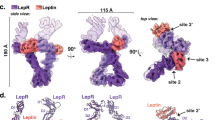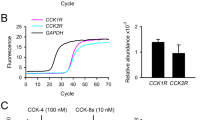Abstract
Leptin, a hormone secreted by adipocytes, regulates the size of the adipose tissue mass through effects on satiety and energy metabolism1–5. Leptin's precise sites of action are not known The leptin receptor (Ob-R) is found in many tissues in several alternatively spliced forms raising the possibility that leptin exerts effects on many tissues including the hypothalamus6–8. Ob-R is a member of the gp130 family of cytokine receptors which are known to stimulate gene transcription via activation of cytosolic STAT proteins9,10. In order to identify the sites of leptin action in vivo, we assayed for activation of STAT proteins in mice treated with leptin. The STAT proteins bind to phosphotyrosine residues in the cytoplasmic domain of the ligand-activated receptor where they are phosphorylated. The activated STAT proteins dimerize and translocate to the nucleus where they bind DNA and activate transcription. The activation of STAT proteins in response to leptin was assayed in a variety of mouse tissues known to express Ob-R. Leptin injection activated Stat3 but no other STAT protein in the hypothalamus of ob/ob and wild-type mice but not db/db mice, mutants that lack an isoform of the leptin receptor. Leptin did not induce STAT activation in any of the other tissues tested. Activation of Stat3 by leptin was dose dependent and first observed after 15 minutes and maximal at 30 minutes. Our data indicate the hypothalamus is a direct target of leptin action and that this activation is critically dependent on the gp-130-like leptin receptor isoform missing in C57BLKS/J db/db mice7,8,11. This is the first in vivo demonstration of leptin signal transduction.
This is a preview of subscription content, access via your institution
Access options
Subscribe to this journal
Receive 12 print issues and online access
$209.00 per year
only $17.42 per issue
Buy this article
- Purchase on Springer Link
- Instant access to full article PDF
Prices may be subject to local taxes which are calculated during checkout
Similar content being viewed by others
References
Zhang, Y. et al. Positional cloning of the mouse obese gene and its human homologue. Nature 372, 425–32 (1994).
Halaas, J.L. et al. Weight reducing effects of the plasma protein encoded by the obese gene (ob). Science 269, 543–546 (1995).
Pelleymounter, M.A. et al. Effects of the obese gene product on body weight regulation in ob/ob mice. Science 269, 540–3 (1995).
Campfield, L.A., Smith, F.J., Guisez, Y., Devos, R. & Burn, P. Recombinant mouse OB protein: evidence for a peripheral signal linking adiposity and central neural networks. Science 269, 546–9 (1995).
Maffei, M. et al. Leptin levels in human and rodent: measurement of plasma leptin and ob RNA in obese and weight-reduced subjects. Nature Med. 1, 1155–61 (1995).
Tartaglia, L.A. et al. Identification and expression cloning of a leptin receptor, OB-R. Cell 83, 1263–71 (1995).
Lee, G. et al. Abnormal splicing of the leptin receptor. in diabetic mice Nature 379, 632–635 (1996).
Chen, H. et al. Evidence that the diabetes gene is the leptin receptor — identification of a mutation in the leptin receptor gene in db/db mice. Cell 84, 491–495 (1996).
Schindler, C. & Darnell, J.J.E. Transcriptional responses to polypeptide ligands: The Jak-STAT pathway. Annu.Rev.Biochem. 64, 621–651 (1995).
Darnell, J.E., Jr Kerr;, I.M. & Stark, G.R. Jak-STAT pathways and transcriptional activation in response to IFN's and other extracellular signaling proteins. Science 264, 1415–1421 (1994).
Ghilardi, N. et al. Defective STAT signaling by the leptin receptor in diabetic mice. Proc.Natl.Acad.Sci.USA 93, 6231–6235 (1996).
Ruff-Jamison, S. et al. Epidermal growth factor and lipopolysaccharide activate Stat3 transcription factor in mouse liver. J.Biol.Chem. 269, 21933–21935 (1994).
Ram, P.A., Park, S.-H., Choi, H.K. & Waxman, D.J. Growth hormone activation of Stat 1, Stat 3, and Stat 5 in rat liver. J.Biol.Chem. 271, 5929–5940 (1996).
Gouilleux, F. et al. Prolactin, growth hormone, erythropoietin, and granulocyte-macrophage colony stimulating factor induce MGF-Stat5 DNA binding activity. EMBO J. 14, 2005–2013 (1995).
Wegenka, U.M., Buschmann, J., Lutticken, C., Heinrich, P.C. & Horn, F. Acute-phase response factor, a nuclear factor binding to acute-phase response elements, is rapidly activated by interleukin-6 at the post-translational level. Mol.Cell.Biol. 13, 276–288 (1993).
Ip, N.Y. et al. CNTF and LIF act on neuronal cells via shared signaling pathways that involve the IL-6 signal transducing receptor component gp130. Cell 69, 1121–1132 (1992).
Hibi, M. et al. Molecular cloning and expression of an IL-6 signal transducer, gp130. Cell 63, 1149–1157 (1990).
Meraz, M. et al. Target disruption of the Stat1 gene in mice reveals unexpected physiologic specificity in the JAK-STAT signaling pathway. Cel/ 84, 431–442 (1996).
Ihle, J.N., Signal transducers and activators of transcription. Cell 84, 331–334 (1996).
Levy, D.E., Kessler, D.S., Pine, R.I. & Darnell, J.J.E. Cytoplasmic activation of ISGF3, the positive regulator of interferon-alpha stimulated transcription, reconstituted in vitro . Genes Dev. 3, 1362–1372 (1989).
Author information
Authors and Affiliations
Rights and permissions
About this article
Cite this article
Vaisse, C., Halaas, J., Horvath, C. et al. Leptin activation of Stat3 in the hypothalamus of wild–type and ob/ob mice but not db/db mice. Nat Genet 14, 95–97 (1996). https://doi.org/10.1038/ng0996-95
Received:
Accepted:
Issue Date:
DOI: https://doi.org/10.1038/ng0996-95
This article is cited by
-
Gut-Brain Axis Modulation of Metabolic Disorders: Exploring the Intertwined Neurohumoral Pathways and Therapeutic Prospects
Neurochemical Research (2024)
-
Hypothalamic-Ovarian axis and Adiposity Relationship in Polycystic Ovary Syndrome: Physiopathology and Therapeutic Options for the Management of Metabolic and Inflammatory Aspects
Current Obesity Reports (2024)
-
Breast feeding, obesity, and asthma association: clinical and molecular views
Clinical and Molecular Allergy (2023)
-
An orally active plant Rubisco-derived peptide increases neuronal leptin responsiveness
Scientific Reports (2022)
-
STAT3 phosphorylation in central leptin resistance
Nutrition & Metabolism (2021)



